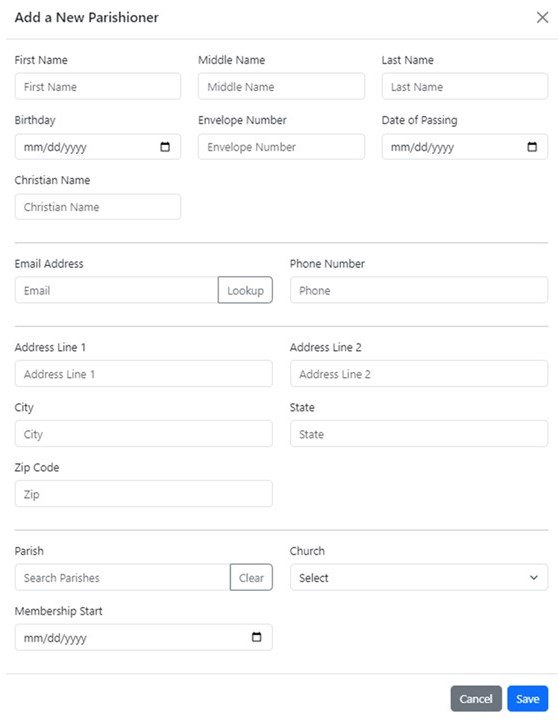For many parishes and dioceses, church management software (ChMS) is the go-to tool for handling membership data, event scheduling, and financial transactions. However, when it comes to tracking sacraments—the spiritual milestones that define a Catholic’s faith journey—these commercial solutions often fall short.
Sacramental tracking is not just an administrative function; it’s a vital aspect of pastoral care and community engagement. Unfortunately, many ChMS platforms treat it as an afterthought, bundling it into a system designed primarily for financial management rather than spiritual formation.
Here’s why it’s crucial to rethink sacramental tracking outside of conventional church management software.
1. Sacraments Are the Core of Catholic Life, Not Just Data Points
A sacrament is more than just an entry in a database; it marks a profound spiritual moment. Baptism, First Communion, Confirmation, Marriage, and Holy Orders are milestones that shape an individual’s relationship with Christ and the Church. Unfortunately, most commercially available ChMS platforms treat sacraments as static records rather than as part of an ongoing faith journey.
By focusing on a dedicated sacramental tracking system, parishes can ensure that every sacrament is properly documented, easily accessible, and serves as a tool for meaningful engagement rather than just another checkbox in a software system designed primarily for accounting.
2. Eliminating Duplicate and Incomplete Records
One of the biggest flaws in traditional church management systems is the lack of a universal, single source of truth for a parishioner’s sacramental history. When individuals move between parishes—or even dioceses—there’s no guarantee that their previous records will seamlessly transfer. This often leads to:
- Duplicate entries, where the same individual is recorded multiple times under different names or variations.
- Incomplete records, where sacramental history is fragmented across different systems.
- Verification difficulties, making it harder for clergy to confirm past sacraments when needed for marriage, ordination, or other rites.
A sacramental tracking system independent of a ChMS can be designed to ensure data integrity, allowing for seamless access across multiple parishes and dioceses while reducing errors and inconsistencies.
3. Streamlining the Process for Clergy and Parish Staff
Many parish staff members will tell you that entering sacramental data in existing ChMS platforms is a tedious, multi-step process. Some systems require navigating through complex menus, while others demand excessive manual input, making it easy for errors to occur.
By contrast, a purpose-built sacramental tracking system can offer:
- A simplified interface, making it easier to enter and retrieve records quickly.
- Automated updates, ensuring that when a sacrament is recorded, it follows the individual across their spiritual journey.
- Custom reporting, allowing clergy to see trends in sacramental participation and proactively engage with parishioners who may have fallen away.
When sacramental tracking is simple, it’s more likely to be accurate and useful in real-world ministry.
4. Strengthening Evangelization and Community Engagement
Parishes that track sacraments effectively can use that data to reach out to parishioners at key moments in their faith journey. Imagine being able to:
- Send a personalized invitation for a Confirmation candidate to begin preparation.
- Reach out to newly married couples to invite them into family ministry or marriage enrichment programs.
- Identify and support individuals who have received some, but not all, of their sacraments, guiding them toward full initiation in the Church.
A dedicated sacramental tracking system allows parishes to move from passive record-keeping to active pastoral care. It transforms sacramental records from mere documentation into a tool for evangelization and relationship-building.
5. Future-Proofing Against Technological and Organizational Changes
Most ChMS solutions are built by for-profit companies whose priorities are not always aligned with the long-term needs of the Church. If a vendor discontinues support, changes pricing structures, or shifts focus away from sacramental tracking, parishes may find themselves locked into an inadequate system with no easy way to migrate their data.
By using a sacramental tracking system independent of a commercial ChMS, parishes can:
- Maintain control over their own data.
- Ensure continuity even if they switch management software.
- Protect sacramental records as sacred, rather than treating them as just another dataset in a financial system.
The Way Forward: A Purpose-Driven Solution
The Church’s mission is not bookkeeping—it’s shepherding souls. Sacramental tracking should be designed with that mission in mind, not as an afterthought within a software package focused on administrative efficiency.
This is why CaDRIS was designed—to give parishes and dioceses a simple, intuitive, and powerful way to track sacraments as a spiritual journey, not just a data entry task. By ensuring that sacramental records are accurate, accessible, and actionable, we help the Church foster deeper connections with its members, guiding them toward a stronger relationship with Christ.
If you’re ready to rethink sacramental tracking and prioritize faith over financials, it’s time to explore a solution that truly puts people before processes.

